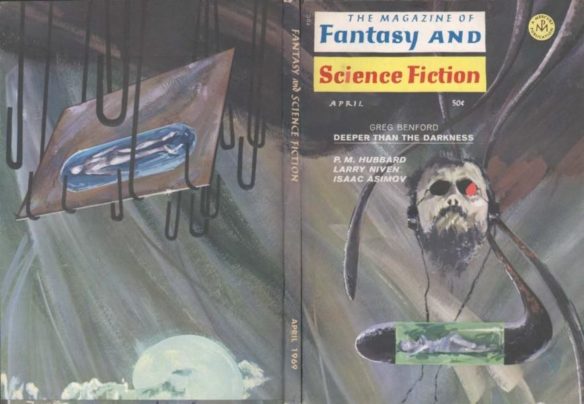(1) A FIGURE OF FUN. Cora Buhlert has posted a new Masters-of-the-Universe-Piece Theatre Photo Story entitled “Held Hostage”. And Cora says, “I have more of those coming up as well, because they’re a lot of fun to make and offer a great distraction from — well — everything.”
(2) ANOTHER LOOK AT LEGENDS. Mark Lawrence takes a deep dive into the work of David Gemmell: “Legends and Re-reads”.
I was a very different person in a very different world when I read Legend at 21 from the man I am at 57. I also know a lot more about writing.
A few things to say about Gemmell.
– He is a skilled storyteller.
– He knows how to push emotional buttons. When I was starting to think about the mechanics of writing he was the first author I looked hard at and said ‘how is he making me feel like this?’
– He had a clear ethos/worldview that runs through all his books. His readers often repeat it as delivered through the eponymous Legend (Druss the Legend, aka Druss of the Axe, aka Deathwalker):
Never violate a woman, nor harm a child. Do not lie, cheat or steal. These things are for lesser men. Protect the weak against the evil strong. And never allow thoughts of gain to lead you into the pursuit of evil.
-The Iron Code of Druss the Legend
(3) RUN AWAY, RUN AWAY! “Lord of the Rings New Movies Set at Warner Bros” reports Variety.
Warner Bros. Pictures is revamping the “Lord of the Rings” film franchise.
On a Thursday earnings call, Warner Bros. Discovery CEO David Zaslav announced that newly-installed studio leaders Mike De Luca and Pam Abdy have brokered a deal to make “multiple” films based on the beloved J. R. R. Tolkien books. The projects will be developed through WB label New Line Cinema. The first “Lord of the Rings” trilogy, helmed by Peter Jackson, grossed nearly $3 billion worldwide; Jackson’s follow-up trilogy based on Tolkien’s “The Hobbit” matched those grosses.
No filmmakers have been attached to the projects as yet, but in a statement to Variety, Jackson and his main “Lord of the Rings” collaborators Fran Walsh and Philippa Boyens said Warner Bros. and Embracer “have kept us in the loop every step of the way.”…
(4) NEXT QUESTION PLEASE. “Helen Mirren says the plot of ‘Shazam! Fury of the Gods’ is ‘too complicated’: ‘Don’t ask me about the plot’” at MSN.com.
Helen Mirren said she doesn’t fully understand the plot of her latest movie, “Shazam! Fury of the Gods.”
Mirren makes her superhero movie debut next month in the DC Comics sequel, playing the film’s villain, Hespera.
During her appearance on “The Graham Norton Show,” which airs in the UK on Friday, Mirren admitted she’s not “a big superhero-type person” but “loved” the first “Shazam!” movie released in 2019.
“Don’t ask me about the plot, it’s too complicated,” Mirren said about her role in the movie. “[Lucy Liu and I] are angry goddesses wearing unbelievably heavy costumes. It was very hot and uncomfortable and in fact, Lucy said at the end of the first day’s shooting, ‘They are trying to kill us,’ in all seriousness.”…
(5) THE INSIDE STORY. Wil Wheaton invites us inside to “see how we are”:
…Last night, Anne and I went to the fancy premiere of Star Trek Picard’s final season at the Chinese Theatre in Hollywood. Before the screening began, after we were all settled into our seats, Terry Matalas and Alex Kurtzman introduced the show, thanked the cast and crew, and turned the spotlight over to Patrick. He spoke lovingly and beautifully about the entire experience, in that Patrick Stewart way we all love.
As he was wrapping up his remarks, he said, “I would like to ask the cast who are here to please stand up,” so they could also be celebrated.
I remembered how humiliating it was, how much it hurt, those times Rick Berman deliberately left me seated while everyone else was standing up, those times Rick Berman made me feel exactly the way my father made me feel: unwelcome, unworthy, invisible. Not a great feeling.
But last night wasn’t about me. Yes, I have a wonderful cameo in season two, but I’m not in season three. And last night was about season three. It was about celebrating my family, who all came together for what is likely their final mission together. So I was happy to stay in my seat while they started to stand up. I clapped so hard my hands are still vibrating this morning. I applauded not just their work on this season, but everything they’ve given to Star Trek for over thirty years. I celebrated the absolute hell out of my family. And while I was doing this, I looked across the aisle at Frakes and clapped at/for him.
We made eye contact, and he gave me this incredulous look. “Why are you sitting down? Stand up, W!” He said.
So I did, and he applauded me, and I may have wept just a little bit. Or maybe a lot. I can’t remember. I was so grateful to be included in the moment by the man who I wish was my father, who loves me and sees me like my own parents never did….
(6) S&S AND $. Cora Buhlert has posted another “Semiprozine Spotlight” for New Edge Sword & Sorcery Magazine. Also, their team is currently running a Kickstarter that’s 85% funded.
Why did you decide to start your magazine?
After having some very exciting discussions last Spring, on the Whetstone Tavern discord, about how to make the S&S scene larger and more inclusive, someone suggested to me that I try to express ideas from that discussion in an anthology. I decided I’d rather do a magazine, but only if there were others who wanted to work with me on it.
There were!
So I set about creating the magazine I wanted to see in the world, made with love for the classics and an inclusive, boundary-pushing approach to storytelling, a gorgeous vessel for high quality writing & art, that would be a delight for Sword & Sorcery fans as well as draw in people from outside the community.
(7) A REAL HEADSCRATCHER. Priya Sridhar knows “How To Steal Right From Squid Game”. Why doesn’t Netflix? (Via Cat Rambo.)
…Here is one difference between the YouTube version of Squid Game and the Netflix reality show: no one got hurt in the former. In fact, you can see the competitors laughing and enjoying themselves. Netflix somehow hurt the production crew and reality competition members.
Sometimes you have to ask one question: how? How do you become the thing that you’re mocking? And how does a corporation remain so oblivious?…
(8) GOODMAN GAMES. [Item by Cora Buhlert.] The good folks of Goodman Games have posted a profile of Margaret St. Clair, mainly focusing on the two novels of hers that are listed in Appendix N (she has written so much more than that, but at least she’s getting attention): “Adventures in Fiction: Margaret St. Clair”.
…Margaret St. Clair is an interesting figure, one whose work is largely overlooked in the present age. St. Clair was one of only three women authors who appeared on Gygax’s list of influential writers and their works. During both the Golden and Silver Ages of fantasy fiction, the field was dominated by white males, so much so that the now-often derided pronouncement on the back cover of the Bantam Books 1963 printing of The Sign of the Labrys (“Women are Writing Science Fiction!”) was actually somewhat shocking. The fact that Appendix N includes three women authors is a testimony to the breadth of Gary’s reading…
And they’ve done a profile of Andre Norton: “Adventures in Fiction: Andre Norton”.
…Norton’s influence on adventure gaming and its creators was not accidental. She often employed a recurring motif in her books in which the protagonist begins as an outsider or “other”, and through dedicating themselves to a perilous journey in the wilderness, eventually becomes a fully-realized heroic figure. The parallels to the level advancement and experience point systems of early role-playing games is obvious….
Also at Goodman Games, Bill Ward reviews A Book of Blade, an anthology in which I have a story: “A Look at A Book of Blades”.
The folks behind the Rogues in the House Sword & Sorcery Podcast have applied their old school sensibilities to create an anthology of contemporary sword-and-sorcery from today’s modern practitioners. Edited by Matthew John, A Book of Blades delivers fifteen tales from an array of authors that fans keeping up with the genre – and especially readers of Tales From the Magician’s Skull – will be sure to recognize, such as Howard Andrew Jones, Scott Oden, John C. Hocking, S.E. Lindberg, Jason Ray Carney, and John Fultz, to name a few. From grimdark to swashbuckling, from all-out-action to moody introversion, the variety of tales found within A Book of Blades presents a fine cross-section of modern sword-and-sorcery….
(9) MEMORY LANE.
1969 – [Compiled by Cat Eldridge.]
Larry Niven’s “Not Long Before the End” is the first work in the setting of The Magic Goes Away universe, published in the April 1969 issue of Fantasy and Science Fiction. It would nominated for a Hugo at Heicon ’70.
Though I always thought of Niven as a SF writer first and foremost, his fantasy writing here is first rate. It’s a wonderful series that shows Niven at his very best.
Now here’s our Beginning…
NOT LONG BEFORE THE END
A swordsman battled a sorcerer, once upon a time.
In that age such battles were frequent. A natural antipathy exists between swordsmen and sorcerers, as between cats and small birds, or between rats and men. Usually the swordsman lost, and humanity’s average intelligence rose some trifling fraction. Sometimes the swordsman won, and again the species was improved; for a sorcerer who cannot kill one miserable swordsman is a poor excuse for a sorcerer.
But this battle differed from others. On one side, the sword itself was enchanted. On the other, the sorcerer knew a great and terrible truth.

(10) TODAY’S BIRTHDAYS.
[Compiled by Cat Eldridge.]
- Born February 24, 1786 — Wilhelm Grimm. Here for two reasons, the first being the he and his brother were the first to systematically collect folktales from the peasantry of any European culture and write them down. Second is that the number of genre novels and short stories that used the Grimms’ Fairy Tales as their source for source material is, well, if not infinite certainly a really high number. I’d wager that even taking just those stories in Snow White, Blood Red series that Terri Windling and Ellen Datlow co-edited would get quite a number based the tales collected by these brothers. (Died 1859.)
- Born February 24, 1909 — August Derleth. He’s best known as the first book publisher of H. P. Lovecraft, and for his own fictional contributions to the Cthulhu Mythos (a term that S. T. Joshi does not like), not to overlook being the founder of Arkham House which alas is now defunct. I’m rather fond of his detective fiction with Solar Pons of Praed Street being a rather inspired riff off the Great Detective. (Died 1971.)
- Born February 24, 1933 — Verlyn Flieger, 90. Well known Tolkien specialist. Her best-known books are Splintered Light: Logos and Language in Tolkien’s World, A Question of Time: J. R. R. Tolkien’s Road to Faerie, which won a Mythopoeic Award, Tolkien’s Legendarium: Essays on The History of Middle-earth (her second Mythopoeic Award) and Green Suns and Faërie: Essays on J.R.R. Tolkien (her third Mythopoeic Award). She has written a YA fantasy, Pig Tale, and some short stories.
- Born February 24, 1941 — Sam J. Lundwall, 82. Swedish writer, translator and publisher. He first started writing for Häpna!, an SF magazine in the 50s. In the late 60s, he was a television producer for Sveriges Radio and made a SF series. He published his book, Science Fiction: Från begynnelsen till våra dagar (Science Fiction: What It’s All About) which landed his first job as an SF Editor. In the 80s, he would start his own company, Sam J. Lundwall Fakta & Fantasi. Lundwall was also the editor of the science fiction magazine Jules Verne-Magasinet between 1972 and 2013. He has been active in fandom as he organized conventions in Stockholm six times in the 60s and 70s. And I see he’s written a number of novels, some released in the U.S., though not recently.
- Born February 24, 1945 — Barry Bostwick, 78. Best remembered for being Brad Majors in The Rocky Horror Picture Show. His first genre undertaking was the English language narration of Fantastic Planet. He voices the Mayor in The Incredibles 2. He also won a Tony Award for his role in The Robber Bridegroom, a play based off the Eudora Welty novella.
- Born February 24, 1947 — Edward James Olmos, 76. Reasonably sure the first thing I saw him in was Blade Runner as Detective Gaff, but I see he was Eddie Holt in Wolfen a year earlier which is I’m reasonably sure his genre debut. Though I didn’t realize it as I skipped watching the nearly entire film, he was in The Green Hornet as Michael Axford. He has a cameo as Gaff in the new Blade Runner film. And he’s William Adama on the rebooted Battlestar Galactica. He has made appearances on Agents of S.H.I.E.L.D. and Eureka.
- Born February 24, 1951 — Helen Shaver, 72. Her SFF debut was as Betsy Duncan in Starship Invasions aka Project Genocide in the U.K. Though you’ve likely not heard of her there, you might have seen her as Carolyn in The Amityville Horror. She’s Littlefoot’s mother in The Land Before Time, and Kate ‘White’ Reilly in the second Tremors film. She’s got one-offs in The Outer Limits, Amazing Stories, Ray Bradbury Theater and Outer Limits to name but a few. And she was Dr. Rachel Corrigan in Poltergeist: The Legacy, an excellent series indeed.
- Born February 24, 1968 — Martin Day, 55. I don’t usually deal with writers of licensed works but he’s a good reminder that shows such as Doctor Who spawn vast secondary fiction universes. He’s been writing such novels first for Virgin Books and now for BBC Books for over twenty years. In addition, he’s doing Doctor Who audiobooks for Big Finish Productions and other companies as well. He’s also written several unofficial books to television series such as the X Files, the Next Generation and the Avengers.
(11) EATING THE FANTASTIC. Scott Edelman invites listeners to get crabby with writer Jennifer R. Povey in Episode 192 of his Eating the Fantastic podcast.

I attended Boskone last weekend, where I recorded three new conversations I’ll be sharing with you, but before we get to those, let’s pay a visit to the previous weekend’s Farpoint, where I had lunch with Jennifer R. Povey at the Ashland Cafe in Cockeysville, Maryland, which offers excellent diner food and great pie.
Povey has made numerous appearances in Analog, and her short fiction has also appeared in such magazines and anthologies as Daily Science Fiction, Bards and Sages Quarterly, Zombiality, 99 Tiny Terrors, First Contact, You’re Not Alone, and many others. Her novels include the four books in the Lost Guardians series — Falling Dusk (2016), Fallen Dark (2017), Rising Dawn (2017), and Risen Day (2018) — as well as the stand-alones Transpecial (2013), Araña (2019), The Lay of Lady Percival (2019), Firewing (2020), and The Friar’s Tale: A Novel of Robin Hood (2020) She also has a number of credits in the RPG industry, having written or co-written supplements for Fat Goblin Games, Rite Publishing, Dark Naga Games, Flaming Crab Games, Avalon Game Company, and others.
We discussed how the pandemic altered the timing of her newly begun five-book science fiction series, why she once had to rethink a novel after getting 20,000 words in, the reason series detectives are rarely the true protagonists in their own stories, our differing reasons for taking issue with J. K. Rowling, her Star Trek fan fiction origins, how to avoid sequel fatigue when writing long series, techniques for avoiding self-rejection, her unusual journey to getting published in Analog, how 20,000 Leagues Under the Sea changed her life, the Doctor Who episode which altered her existential understanding of the universe, how her archeological training helped her fiction, what writers get wrong when depicting horses, how it’s possible for pantsers to write novels, the time she horrified a Klingon in a convention bar, the divisive nature of “ship wars,” and much more.
(12) ASTEROID SCIENCE. [Item by SF Concatenation’s Jonathan Cowie.] Today’s US leading journal Science is sort of SFnal related.
An artist’s impression shows the Hayabusa2 spacecraft retrieving a sample from the surface of asteroid (162173) Ryugu. A combined total of 5 grams of samples were collected from two locations on Ryugu and then brought to Earth. Laboratory analysis of the samples has now determined the composition, formation process, and evolutionary history of the asteroid.

There’s also an open access introduction to the special section to which this cover relates here: “An asteroid in the laboratory”.
One other part of the special selection is on noble gases and nitrogen in the asteroid here: “Noble gases and nitrogen in samples of asteroid Ryugu record its volatile sources and recent surface evolution”.
The noble gas and nitrogen composition of this non-carbonaceous asteroid is of interest as they indicate how much more volatile components (such as carbon dioxide, methane and water) might have originally been there. So they also compiled a basic model of the Solar system including temperature and radiation environments in space with distance from the Sun as well as cosmic ray exposure. From this they infer that Ryugu’s orbit migrated from the main asteroid belt to the near-Earth region ~5 million years ago.
A recently published piece on the likely water content of non-carbonaceous meteorites suggests that much of the water delivered to Earth came from non-carbonaceous meteorites/asteroids/planetismals crashing into the primordial Earth. It is quite likely that as the above current work on the Ryugu samples continues that it will tie into this other, previous work.
At the moment there is some debate as to how Earth got its water. Was it through early accretion as our planet formed or through the late veneer 4.42 billion years ago a short (geologically/astronomically) time after the Earth formed? The answer is likely to be a mix of one and the other, but to what proportion remains highly debatable. Now, of SFnal interest, all these questions have a bearing on the likelihood of life-bearing Earth-like planets in habitable zones around other stars. This, in turn, relates to the far more important question of the likelihood of finding good bars, serving decent real ale, across the Galaxy.
(13) HOPE IS HARDER THAN DESPAIR. TBRCon2023 Panel 29 “Hopepunk & Optimistic Futures”. (Via Cat Rambo.)
Join moderator/author Jonathan Nevair and authors Cat Rambo, Ruthanna Emrys, Matthew Kressel and Sarena Ulibarri for a TBRCon2023 author panel on “Hopepunk & Optimistic Futures”!
(14) MASTER OF THE MASTERS. [Item by Cora Buhlert.] In 2022 the Geek Dad Live YouTube channel interviewed Ted Biaselli, who is a producer for many SFF shows at Netflix. The interview is mainly about Masters of the Universe: Revelation, but Biaselli has also produced Wednesday, The Dark Crystal and many others. Super enthusiastic and very likeable guy:
Join John and Jay as they iscuss Masters of the Universe with fellow toy geek and Executive Producer of MOTU : Revelation, Ted Biaselli! They’ll talk about their thoughts on Season 1, the toys supporting the show, and whatever he can share about a potential second Season of the Show! They’ll discuss the latest in toy news like the conclusion to the Mattel Vs. the Dino Channels affair. They’ll talk about all of the Star Wars reveals by hasbro this week, share their latest toy hauls and try to Stump John, all of that and more tonight on Toy Geeks!
[Thanks to SF Concatenation’s Jonathan Cowie, Andrew Porter, Michael Toman, Cora Buhlert, Cat Eldridge, Mike Kennedy, John King Tarpinian, and Chris Barkley for some of these stories. Title credit belongs to File 770 contributing editor of the day Jake.]



